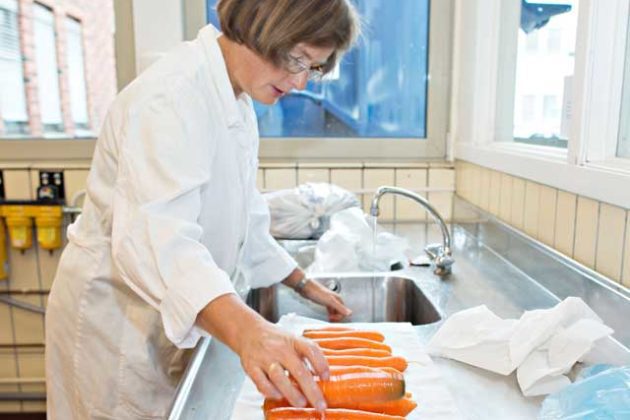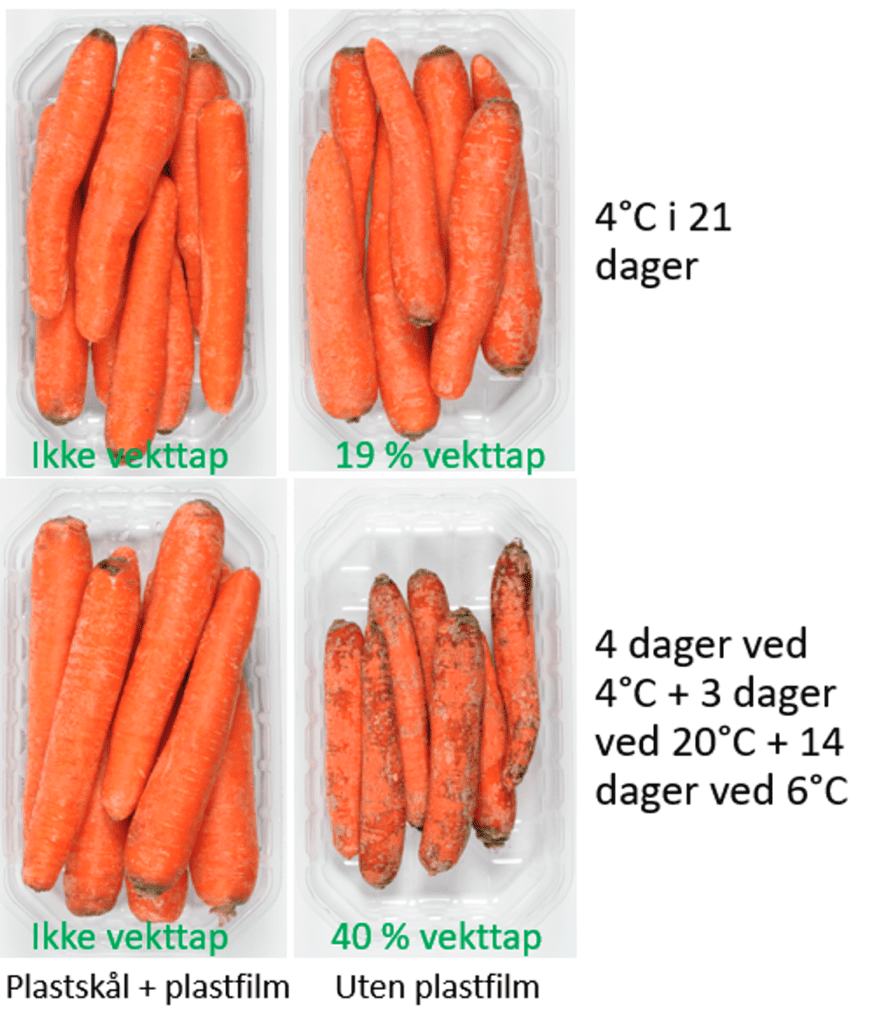How to improve the shelf life of fruit and vegetables

Correct storage and packaging increase the shelf life of fruits, berries, and vegetables. Nofima scientists have studied different vegetables to see how they react under different conditions.
Fruits and vegetables contain a lot of water and continue to breathe (respire) after they have been harvested. Therefore, they quickly become shrunken and deteriorate in quality if the temperature is too high or the packaging is inadequate. The products that are not packaged are particularly susceptible to weight loss and drying out, and they dry out much quicker at high storage temperatures. The general advice for maintaining quality is to store fruits, berries and vegetables at cool temperatures, around 10°C or in a refrigerator at around 4°C.
Not all types of vegetables are equally susceptible to drying out. Tomatoes, for example, are less susceptible. Nevertheless, packaging has a protective effect. It reduces the risk of damage during handling and transport. Damage is a major reason why tomatoes and other vegetables deteriorate faster.
The general advice for maintaining quality is to store fruits, berries and vegetables at cool temperatures, around 10°C or in a refrigerator at around 4°C.
Different vegetables require different storage
“Among other things, we tested carrots, red peppers, cucumbers, and tomatoes. Carrots, red peppers and cucumbers last longer when packaged in plastic. How tomatoes should be stored varies depending on the variety”, says Hanne Larsen, Senior Scientist at Nofima. She has led the research work.
Different vegetables require different storage. Carrots and swedes last longer when stored in refrigerators, while tomatoes, cucumbers and peppers benefit from cool storage (10 °C). Plastics prevent moisture loss and keep products firm and crisp, but high moisture levels inside the plastic can stimulate microbial growth, especially when stored at 10°C.
“There may also be differences between different varieties of the same type of vegetable. Mini plum tomatoes, for example, have a relatively thick skin and can withstand storage for an extended period of time at a high temperature before they suffer a significant weight loss. Romanse tomatoes have stems and are more susceptible to mould growth on the stems under less favourable storage conditions”, explains Nofima scientist Kjersti Aaby.
Storage in grocery stores is of great importance regarding shelf life
A lot of fruit and vegetables are stored at room temperature in stores. This has a negative effect on the quality. Even a short period at room temperature can ‘stress’ fruits and vegetables and increase respiration. This reduces quality and shelf life and increases the risk of food waste.
For example, carrots dry and shrivel quickly at room temperature, especially if they are not packaged in plastic. Nofima scientists stored several packages of carrots under different conditions for 21 days.
“During the 21 days, the carrots that were stored for three days at room temperature and without being packaged in plastic lost 40 percent of their weight, while the weight loss was 19 percent for the carrots that were stored at a cold temperature throughout the entire period. Carrots packaged in plastic did not lose any of their weight, but those that were stored for three days at room temperature were more prone to developing rot and sprouting”, says Hanne Larsen.
“A few days of storage at room temperature also resulted in deterioration of the quality of swedes, especially small swedes”, says Kjersti Aaby. For example, the weight loss of small swedes was 32 percent after being stored for three days at room temperature followed by cold storage for three weeks, while large swedes only lost 19 percent of their weight when stored under the same conditions.

Do fruits, berries and vegetables need to be packaged in plastic?
There is great scepticism towards plastic packaging, and it is important to document whether plastic packaging is necessary and whether it contributes to better shelf life and less food waste. That was the goal of the project HoldbarSjekken.
BAMA was the project owner, and in collaboration with Nofima and other project partners, they have developed a knowledge-based test system for selecting the right packaging for fruit and vegetables. The purpose of the system is to streamline testing of future packaging solutions for existing and new products.
Systematic shelf life studies have been carried out to compile documentation that shows the shelf life of selected products. These were stored in plastic, fibre and without packaging under optimal and more realistic temperature conditions.
Weight loss and changes in sensory characteristics such as taste, smell or texture were regularly recorded during the storage period. The relevant sensory characteristics were adapted to each product and were in accordance with BAMA’s quality requirements and tolerance levels.
Facts about the project
HoldbarSjekken is an innovation project funded by the Research Council of Norway (2020-2022) with BAMA Gruppen as project owner. The research work was led by Nofima. Other project participants were the packaging suppliers Moltzau Packaging and NNZ, Gartnerhallen and the grocery chains NorgesGruppen and Rema 1000.
Contact persons
Research facilities
Food Packaging Pilot Plant
Projects

